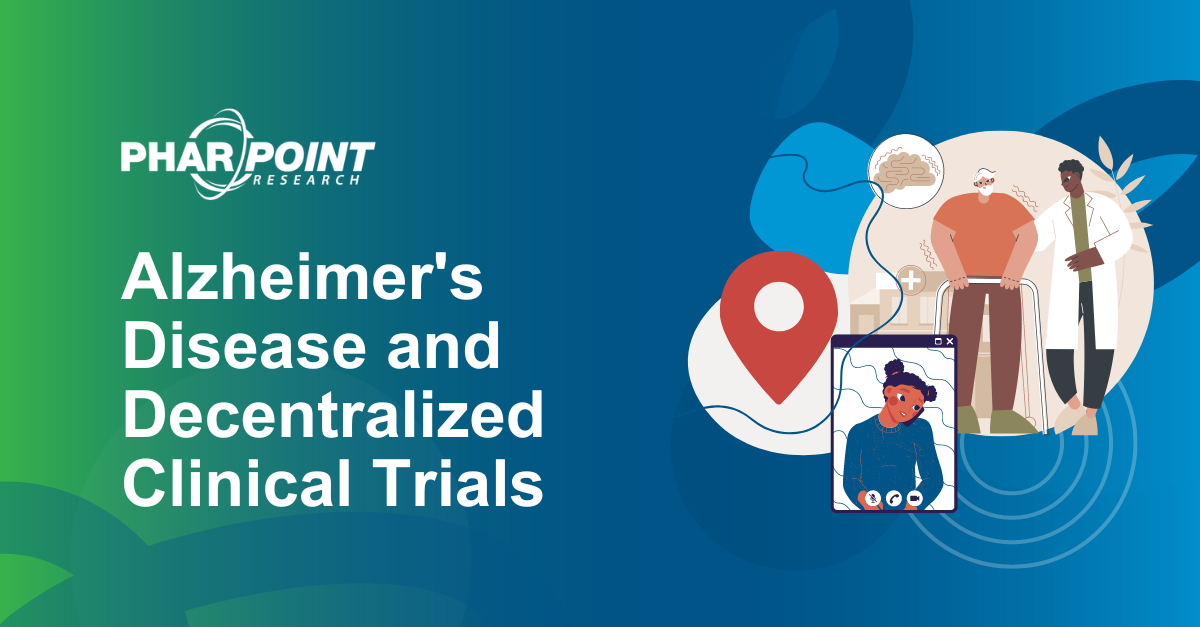Alzheimer’s Disease & Decentralized Clinical Trials
Alzheimer’s Disease (AD) impacts millions of people across the United States.
As of 2021, according to research from the Alzheimer’s Association, more than 6 million people are living with the disease. That same report also states that over 11 million Americans provide unpaid care for people with Alzheimer’s or other dementias [1].
Experts across the industry remain cautiously optimistic about the development of new treatments that can stop or significantly delay AD progression. One way researchers may be able to explore new ways to expedite study timelines and bring effective treatments to market faster is through the use of decentralized study aspects.
Benefits and Challenges of Using Decentralized Technology in Alzheimer’s Clinical Trials
Keeping Caregivers in Mind
An Alzheimer’s Disease clinical trial must not only be patient-centric, but also participant-centric, keeping in mind the burden a study has on caregivers.
As patients diagnosed with Alzheimer’s progressively lose more and more cognitive functions, they become increasingly reliant on caregivers. Caregivers often are in charge of daily needs, including reminders to take medication as well as transportation. This heavy reliance on the caregiver means that study recruiters must not only enlist the patient diagnosed with Alzheimer’s disease but their caregiver as well.
Traditionally, the time and travel burden on caregivers was immense as they set aside their own needs to get patients to and from a study and deal with potentially time-consuming procedures. This burden may be amplified by the fact that caregivers may have a health condition of their own – for example, they may be a spouse with limitations in mobility or have a cognitive disruption of their own.
When a Sponsor is able to incorporate decentralized aspects into their Alzheimer’s study, they make the clinical trial process easier on both patients and caregivers.
Benefits of Using Tech in AD Studies
eCOA (electronic clinical outcome assessment) tools, including patient, observer, and clinician-reported outcomes via telemedicine or home health visits, are excellent tools for AD studies. Just because a study is focused on an older population does not mean that a decentralized approach should be immediately ruled out, especially as overall technology adoption continues to increase and caregivers may be capable of receiving adequate training and instruction to use technologies.
According to 2021 information by Pew Research Center, 92% of adults aged 65+ have a cellphone, and 61% own a smartphone. Additionally, 96% of adults aged 50-65 and 75% of adults age 65+ report that they use the Internet [2].
Technology use in trials – including Alzheimer’s Disease trials – has shown numerous benefits. This includes:
- Increased geographic reach
- The ability to recruit more representative populations
- Reduced rater burden
- Reduced participant burden
The ability to reach more potential subjects across a more diverse geography is a huge advantage for AD studies. One of the main challenges in Alzheimer’s is that the patient population is disproportionately rural, and the clinical trial center population is disproportionately urban. This leaves centers with competing trials chasing only a portion of the potentially eligible participants.
The ability to collect outcome measures without the need for an on-site visit is another important advantage of decentralization. AD studies tend to be very long, and visits to and from sites may be incredibly burdensome on patients and caregivers. By swapping some in-person, on-site visits with visits that use local locations and at-home telehealth, patient burden is substantially decreased.
Ensuring Validation and Integrity in Remote Data Collection
How can sponsors be certain that they’re collecting the data that’s needed using remote/virtual methods while ensuring that validation and integrity are maintained?
Regulators are increasingly supportive of the use of data captured from digital sources (such as wearables), and research has shown that interview-based assessments (for example, CDR and ADCS-ADL) produce consistent results whether administered via telephone or face-to-face [3].
There is a growing interest in digital cognitive assessment tools, and the landscape of these tools is quickly evolving as technology advances, older adults continue to increase tech adoption, and more clinical trials are conducted within remote environments.
Keeping it Local: Improving Patient Retention
Decentralized trials may be considered a key strategy for ensuring patient and participant retention, as quality of life can be significantly impacted by rigorous study routines.
Under traditional circumstances, AD clinical trials must be performed at sites local to patients and their caregivers. As it was previously noted, the travel burden for Alzheimer’s patients typically falls upon their caregivers. If a site is too far away from a patient, the chance of missed visits/patient dropout may increase.
A decentralized study approach may not just increase patient retention; it may be a way to decrease patient agitation and anxiety as patients are able to participate from more familiar locations. Anxiety symptoms are very common in patients with dementia, with prevalence estimates ranging from 8% to 71% for anxiety symptoms and from 5% to 21% for anxiety disorders [4].
Keys to Decentralization
Decentralizing your study allows investigators to reach otherwise potentially willing and eligible patients who are deterred by long-distance travel and high participant burden.
Finding a contract research organization that can understand the nuances of both Alzheimer’s Disease clinical research and DCTs, including how the two areas may overlap and interact, is an essential part of your CRO selection criteria.
[1] Alz.org. 2021. 2021 ALZHEIMER’S DISEASE FACTS AND FIGURES. [online] Available at:<https://www.alz.org/media/Documents/alzheimers-facts-and-figures-infographic.pdf> [Accessed 21 September 2021].

